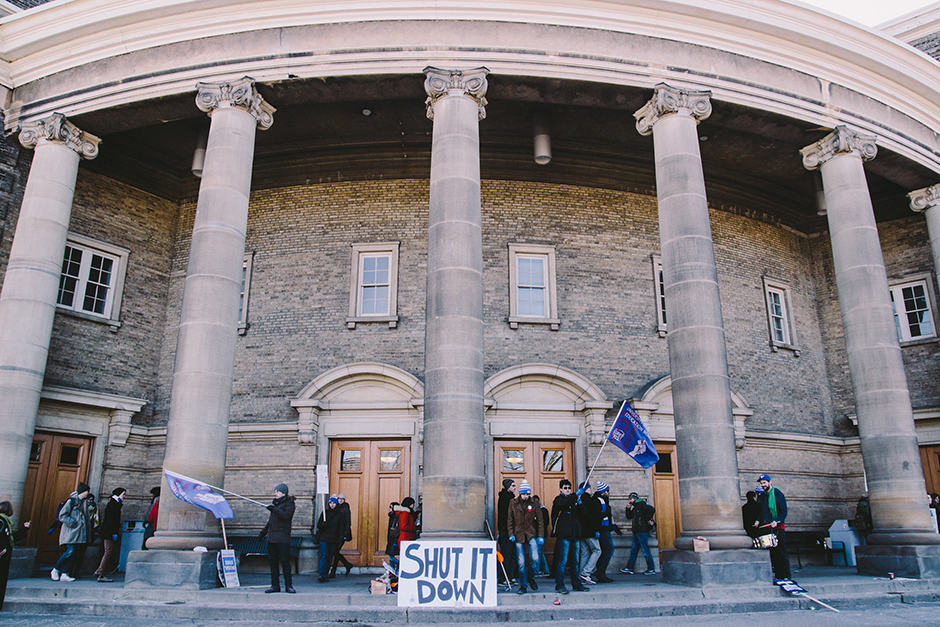One month after it began, the strike is over.
On Thursday, March 26, the members of CUPE 3902 Unit 1 voted to accept binding arbitration in their contract negotiations with the University of Toronto and return to work on Friday, March 27.
“I’m happy to have classes back, the [teaching assistants] back, getting my work marked and tutorials back and running,” says Marcos Perez, a third-year student who had two of his classes affected by the strike.
The final vote count was 942 in favour with 318 opposed, ending the strike by some 6,000 teaching assistants (TAs), exam invigilators, and other university staff that began on February 27.
“I think members are going back to work tomorrow with their heads held high,” says Ryan Culpepper, one of the chief negotiators for Unit 1. “I think the vote count shows that members are very confident in our bargaining proposals, and confident we are going to win in arbitration.”
“We are enormously relieved that the strike is over,” said U of T president Meric Gertler in a statement released Thursday. “A number of challenges remain, as we work together to return to regular functioning over the next few weeks.”
By going to binding arbitration, both the university and the union have agreed ahead of time to accept the decision of a neutral third party.
According to Culpepper, much work remains, with each side slated to submit a proposal and present oral arguments. The arbitrator can choose the proposal of one side or the other, or find a way to resolve the two.
“I took it as a concession from them,” says Culpepper of the arbitration offer. “I was surprised that they would be willing to have arbitrated things that they’ve said all along are fundamental matters of principal.”
Gertler’s statement thanked students for their patience, and also contained conciliatory words for union members.
“Our task now is to work together to support our undergraduate and graduate students as they complete their term,” he said.
The long and winding road
The strike began when CUPE 3902 Unit 1 voted down an eleventh-hour tentative deal proposed by the university. Lively picket lines formed across campus, with the corner of St. George and Hoskin, outside Sidney Smith Hall, near the Rotman Commerce building, and the entrance to King’s College Circle on College Street being among the most heavily picketed areas.
Many academic activities were cancelled, suspended, or otherwise disrupted as a result of the labour shortage. Labs and tutorials were lost, and large numbers of assignments went ungraded.
Some undergraduate students took initiative and tried to make up their study time by forming informal reading groups.
Some classes were held on picket lines or off-campus, and at least one lecture normally held in Convocation Hall took place on Front Campus.
Although many professors amended their syllabi to mitigate the effects of the strike, The Varsity received reports of instructors from other CUPE 3902 units filling in for the striking TAs.
Unit 3, which represents sessional lecturers, reached a settlement with the university on March 10 and thus did not go on strike.
Though the university and Unit 1 negotiated several times, they repeatedly failed to reach a deal. Unit 1 proposed an agreement to the university on March 13. The university declined to accept it and offered a counter proposal, which Unit 1 did not accept.
On Wednesday, March 18, the two sides reached a tentative agreement, which was voted down in the early hours of March 23 with 1,101 no votes to 992 yes, 27 disallowed, and four spoiled. This development extended the strike for another three days.
Undergraduates unsatisfied
As the strike entered its third week, undergraduate students across all three campuses acted in solidarity with their TAs.
Over 1,000 students at the St George campus participated in a walkout on March 18, congregating in front of Simcoe Hall, the building that houses many of the university’s most important administrative offices. Their counterparts at UTM rallied outside of UTM principal Deep Saini’s office and demanded that he meet with them regarding the strike.
Similarly, students at UTSC staged a sit-in at their registrar’s office on March 19 in solidarity with CUPE 3902. Their actions followed the release of a letter dated March 17 from UTSC’s academic directors, which called for the provost to agree to a minimum funding package for graduate students.
University attempts to save the semester
The university announced a strike contingency plan on March 23, which some were quick to dub “academic continuity.”
The plan includes giving students the chance to declare any full- or half-year courses offered this year credit/no credit (CR/NCR) even after the final marks are revealed — regardless of whether or not they were affected by the strike. These courses do not count towards the 2.0 credit CR/NCR maximum.
Students may also drop courses past the end of the semester without academic penalty.
The term will not be extended and the April exam period will proceed as scheduled; however, the Faculty of Arts & Science has warned that some final exams may be altered or cancelled.


